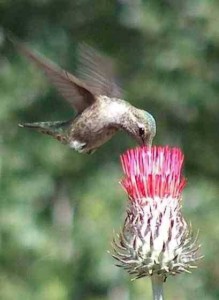 Nectar is a dilute solution of various sugars, and, in some flowers, also contains low concentrations of polysaccharides, amino acids, and lipids. No bird can rely entirely on nectar because of its lack of essential amino acids. Insects are usually the other food birds eat that supplies the nutrients missing in nectar. Hummingbirds are the most prominent birds that rely heaviliy on nectar in their diet.
Nectar is a dilute solution of various sugars, and, in some flowers, also contains low concentrations of polysaccharides, amino acids, and lipids. No bird can rely entirely on nectar because of its lack of essential amino acids. Insects are usually the other food birds eat that supplies the nutrients missing in nectar. Hummingbirds are the most prominent birds that rely heaviliy on nectar in their diet.Most nectarivores have relatively long narrow beaks and tongues which seem to be an adaptation for retrieving nectar from flowers. Tongues contain grooves, bristles, and papillae, which increase the surface area and facilitate capillary action to draw up the nectar. Birds can consume the abundant nectar in flowers quickly. A hummingbird can fill up its large crop with nectar and then rest while the crop empties during digestion. Nectarivores tend to have smaller, less muscular gizzards and shorter intestines. The proventricular and pyloric openings of most nectarivores lie in the same plane, so that nectar can bypass the lumen of the gizzard. Ceca are vestigial and the rectum is short.
Nectar is digested rapidly and almost completely. A hummingbird can obtain a metabolizable energy content of glucose, fructose, and sucrose of greater than 95%. To obtain the other nutrients they need, adult hummingbirds spend about 25% of the time foraging for soft-bodied arthropods and increase this effort during breeding and raising young.
Consuming high quantities of nectar imposes the necessity of high rates of excretion and the loss of electrolytes that must be replaced. Such replacement may come primarily from insects, but also from eating sand or licking ashes.
Nectarivores have altricial young with rapid growth and high protein requirements. Adult nectarivores feed their young a predominantly insect diet with increasing amounts of nectar as they age.
Flowers that attract their nectarivore pollinators tend to be red and scentless. The dilute sugar and amino acid concentrations facilitate rapid uptake by the birds, as opposed to higher concentrations in flowers pollinated by insects. Low concentrations may also promote wider foraging by birds and a wider distribution of pollen among the flower population.